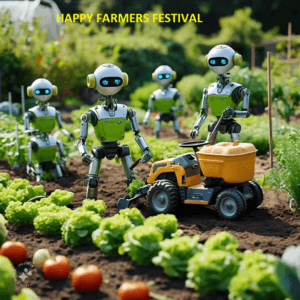
Introduction
Applying AI in farming is the best thing that has happened to the agricultural sector and farming, as it brings smart technology solutions to timeless problems. With predictive analytics, robotics, and many other techniques, AI provides farmers with an opportunity to increase crop production rates, lower expenses, and act as caretakers of resources. Fellow farmers!
Welcome to this Farmers Festival in Tamil Nadu. In today’s episode, let’s understand how AI revolutionizes farming.
What is AI in Farming?
AI in farming can be described as the use of machine learning, robotics, computer vision, or any other artificial intelligence-based technology to execute farming. This technology provides the capability to make better decisions based on real-time, highly processed data. Farmers can benefit from:
Modern farming methods
Machine for seeding and reaping of crops / production line.
Pest and disease control methods
REASON FOR FOCUSING ON AI IN MODERN FARMING
There are some issues that the farming and agriculture sector is experiencing, such as climate change, soil erosion, and irregular water supply. AI helps:
- Monitor weather conditions
- Analyze soil quality
- Automate irrigation systems
Applications of AI in Farming
Farming through the use of this technology increases productivity and also has a positive impact on the environment. Key applications include:
Precision Agriculture
The AI-based applications for agriculture include satellite and drone images for tracking crop status and identifying irregularities. Farmers get information on how best to use water, fertilizers, and pesticides.
Having access to affordable AI-based tools and equipment remains a challenge, according to many farmers.
Need for Technical Knowledge
One of the challenges is that the implementation of AI calls for learning in data analysis and how software works.
AI and farming success stories
- Example 1: A farmer in Tamil Nadu used AI-based smart technologies for watering crops, and he saved 30% of water.
- Example 2: Through the use of drones, the grape in a vineyard in California was observed using artificial intelligence technology to boost the yield to 20%.
The Future of AI in Farming
AI in farming is set to expand further with innovations like:
- Blockchain Adoption for Enhancing Supply Chain Transparency.
- Smart sensors by implementing IoT for better efficient resource usage.
- HVAC AI-based vertical farming in urban regions.
Automated Farm Equipment
Robots powered by AI can:
- There are indications that seeds must be sown at specific depths.
- Spray weed fields without harming crops.
- Teach where to cut fruits with great precision and at the same time in the shortest duration possible.
Benefits of AI in Farming
AI’s integration in agriculture provides numerous benefits, including:
- Potential crop increases: using predictive data analysis.
- Hiring the services of software to automate the entire process as a way of cutting down on the labor cost.
- Similar to real-time monitoring, it enables efficient utilization of resources.
- Diseases and pests detection at their early stages.
- Organic farming practices that involve the least production of waste.
Challenges of AI in Farming
Despite its benefits, implementing AI in farming presents challenges, such as:
High Initial Investment
How to Use AI for Agriculture
To implement AI in your farm, consider these steps:
- Identify what is best for your farm.
- Search for artificial intelligence tools specific to the needs of your business.
- Look for government grants or initial capital from the government in starting the business.
- Participate in workshops or take an online course in order to develop technical competencies.
Conclusion
The use of AI in farming has been made very important as it helps in making better, sustainable farming practices. While Tamil Nadu celebrates Farmers Festival, what better option is available for adopting these innovations? Don’t wait for your competitors to embrace the AI automation future while you stagnate—start with the first steps now and enjoy the rewards in the following years.

